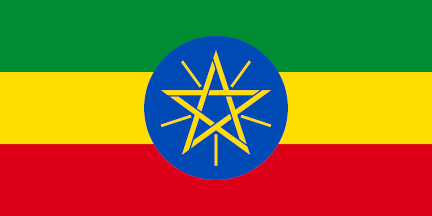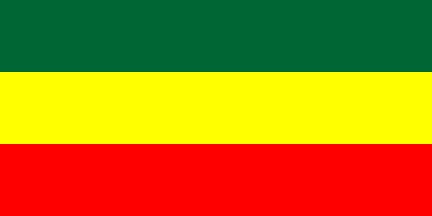
![[National flag and ensign]](../misc/oooooo.gif) 1:2
Image by Zoltan Horvath, 31 May 2024
1:2
Image by Zoltan Horvath, 31 May 2024Flag adopted on 06 February 1996, coat of arms (emblem) adopted 06 February 1996.

Last modified: 2025-04-19 by bruce berry
Keywords: ethiopia |
Links: FOTW homepage |
search |
disclaimer and copyright |
write us |
mirrors

![[National flag and ensign]](../misc/oooooo.gif) 1:2
Image by Zoltan Horvath, 31 May 2024
1:2
Image by Zoltan Horvath, 31 May 2024
Flag adopted on 06 February 1996, coat of arms (emblem) adopted
06 February 1996.
See also:
Ethiopia is a land-locked country in the Horn of Africa, bordered by Eritrea in the north, Sudan and South Sudan to the west, Djibouti and Somalia to the east and Kenya in the south. It is the most populous land-locked country in the world.
Ethiopia has been a monarchy for most of its history
and the Ethiopian dynasty traces its roots to the 2nd century BC. During
the Scramble for Africa, Ethiopia was one of only two African countries to
retain its independence and was one of only four members of the League of
Nations. After a brief period of Italian occupation during World War II,
Ethiopia became a charter member of the United Nations. Many African
countries adopted the colours of the Ethiopian flag on their flags when they
achieved independence which, together with black, became known as the
Pan-African colours.
Bruce Berry, 10 Dec 2010
The current flag of Ethiopia was adopted on 06 February 1996
and is a green-yellow-red tricolour with the national emblem in the centre. The emblem,
also used as the coat of arms, is light blue disk with a diameter approximately half
length of the hoist
inscribed with yellow pentagram symbol.
Željko Heimer, 29 Aug 2001
The Federal
Negarit Gazette, the official publication by the Ethiopian
Government to document all of the laws recently passed, has a scan of a document
dated 28 August 2009 which contains the law about the
Ethiopian flag, its size and construction.
When it comes to the construction, some of the information we have is correct.
For example, the ratio is still 1 x 2. One thing I did notice in Part 3,
Article 6, Section 1 regards the National Emblem. The direct quote from the law:
"The Flag shall have the colours: green at the top, yellow at the middle and red
at the bottom together with a National Emblem of circular blue background. The
Emblem shall be set at the centre of the Flag in such a way
that its circumference curves on the mid-point of the width of both the green
and red colours."
If I am reading this right, should the emblem be 2/3rds of the width of the
flag.
Zachary Harden, 02 May 2010
Another document found
online at the website of the University of Minnesota, shows a scan of the
Federal Negarit Gazette of 31 October 1996 establishing Proclamation No.
48/1996 amending the "Flag and Emblem Proclamation" No. 16/1996.
According to this document, the size of the emblem had already changed from 1/2
to 2/3 of the flag width back in 1996 by this Proclamation. The document
includes a colour image of the flag
to confirm this.
Antonio Gutiérrez, 28 May 2010
Based on information and a picture from the Ethiopian Embassy in Washington DC,
the disc only just overlaps the top and bottom stripes. The pentagram is actually made of five Y-shapes, each rotated 72 degrees around the centre of the star to make the new one.
Graham Bartram, 02 July 1996
Constitution of Ethiopia only defines the flag:
https://www.ethiopianembassy.be/wp-content/uploads/Constitution-of-the-FDRE.pdf
Flag Proclamation 16/1996 described and illustrated the flag (with light
blue disc):
https://mesfinbelachew.net/proclamations/16_1996.pdf
Flag
Proclamation 654/2009 replaces the previous proclamation (illustration is
missing from this copy), but it defines a darker shade of blue disc:
https://mesfinbelachew.net/proclamations/654_2009.pdf
Note: Article 16
determines the only flag is what is specified in that proclamation (civil flag
was outlawed).
Zoltan Horvath, 31 May 2024
The protocol manual for the London 2012 Olympics
(Flags and Anthems Manual, London, 2012 [loc12])
provides recommendations for national flag designs. Each National Olympic
Committee was sent an image of their flag, including the PMS shades, by the
London Organising Committee of the Olympic Games (LOCOG) for their approval.
Once this was obtained, the LOCOG produced a 60 x 90 cm version of the flag for
further approval. So, while these specifications may not be the official,
government, version of each flag, they are certainly what the National Olympic
Committee believed their flag to be.
For Ethiopia: PMS 347 green, process yellow, 032 red, 638 blue. The vertical
flag is simply the horizontal version turned 90 degrees anti-clockwise.
Ian Sumner,
10 Oct 2012
Other sources for colors:
The Flag Manual - Beijing 2008 gives
Pantone colors: PMS 032 (red), PMS 293 (blue), PMS 109 (yellow), and PMS 355
(green). The flag is illustrated with a dark blue disc.
The Album des
Pavillons 2000 [pay00] gives approximate colors
in Pantone and CMYK systems:
Red: Pantone 179c, CMYK 0-80-95-0
Yellow:
Pantone 108c, CMYK 0-0-100-0
Dark green: Pantone 349c, CMYK 100-0-85-40
Blue: Pantone 2995c, CMYK 100-10-0-0
The flag is illustrated with a light
blue disc.
Flags and Anthems Manual London 2012 [loc12]
gives Pantone colors: PMS 347 (green), PMS Yellow, PMS 032 (red), PMS 638
(blue).
The Album des Pavillons 2023 specifies the colors of the flags in
three color systems.
Blue: Pantone 2132c, CMYK 94-73-0-0, RGB 0-169-224
Red: Pantone 186c, CMYK 14-100-79-4, RGB 200-16-46
Yellow: Pantone Yellow c,
CMYK 3-9-92-0, RGB 254-221-0
Green: Pantone 355c, CMYK 84-12-100-1, RGB
0-149-48
The flag is illustrated with a light blue disc.
Vexilla Mundi gives colors in Pantone
system: PMS 347C (green), PMS Yellow C, PMS 032C (red), and PMS 293C (blue).
The flag is illustrated with a dark blue disc.
Wikipedia gives color values as follows:
Green: Pantone 347C, RGB 7-137-48, Hex #078930ff, CMYK 95-0-65-46
Yellow: Pantone Yellow C, RGB 252-221-9, Hex #fcdd09ff, CMYK 0-12-96-1
Red: Pantone 032C, RGB 218-18-26, Hex #da121aff, CMYK 0-92-88-15
Blue:
Pantone 2728, RGB 15-71-175, Hex #0f47afff, CMYK 91-59-0-31
The flag is
illustrated with a dark blue disc.
Flag Color Codes gives the following color values:
Green: Hex: # 009A44, RGB 0, 154, 68, CMYK 92, 0, 97, 0, Pantone 347, RAL
6024
Yellow: Hex: # FEDD00, RGB 254, 221, 0, CMYK 0, 1, 100, 0, Pantone
Yellow, RAL 1026
Red: Hex: # EF3340, RGB 239, 51, 64, CMYK 0, 90, 76, 0,
Pantone 032, RAL 3024
Blue: Hex: # 0645B1, RGB 6, 69, 177, CMYK 99, 76,
0, 0, Pantone 2728, RAL 5017
The flag is illustrated with a dark blue disc.
Zoltan Horvath, 31 May 2024
 Image by Ivan Sache, 18 July 2000
Image by Ivan Sache, 18 July 2000
Probably the most widespread Ethiopian flag in general use, no matter what the central symbol was official at
any given time, is the plain green-yellow-red tricolour. My interpretation
for this is
that the flag with emblem is too complicated and expensive to manufacture,
whereas everyone is able to identify correctly a "plain" Ethiopian flag. The "plain" flag seems to be usually 2:3 in proportion and not
in the official 1:2. I would say that the "plain" flag is a kind of non-official "civil" flag.
Ivan Sache, 18 July 2000
I visited Ethiopia a few months ago (a great country to visit despite the
poverty), and I
can confirm that the vast majority of national flags there are flown without the blue disk and star in the
middle. However, the blue disk and star appears on many government documents including my visa,
declaration forms, exchange forms, etc. The flag with the disk and star can be seen at the airport,
government offices, and almost nowhere else. The Ethiopians are quite fond of their flag and it, as
well as paintings of it, are frequently seen but without the disk and star.
Robert Wilson, 26 Dec 2002
The green-yellow-red flag appeared in 06 October 1897. It was the flag of Ethiopia that became the basis for the
Pan African colours. Before the end of the Ethiopian Empire the colours were interpreted as: red for power and faith; yellow for church, peace, natural wealth and love; and green for land and hope. The colours were also
interpreted as having a connection to the Holy Trinity, and the three main provinces. At first the flag was used as three separate
rectangular strips with red at the top. At some point the order of colours was changed.
Željko Heimer, 14 Dec 1995
From a website no longer active:
According to the Flag and Emblem proclamation colours and shape of the flag is:Dov Gutterman, 07 May 1999The Flag shall have the colours: green at the top, yellow at the middle and red at the bottom.
The colours shall be bright and basic.
The colours shall be structured horizontally and be of the same size. The length of the Flag shall be twice its width.
The Emblem shall be a blue circle with depictions:
a) straight and equal lines of yellow that come from all directions and join each other;
b) a star formed by the straight and equal lines;
c) yellow rays radiating from the joints of the straight and equal lines.
Regarding the order of the colours, as noted elsewhere, the
original 1897 flag was flown with red at the top. It was
explained to me that the flag was still traditionally flown "upside-down"
with red at the top when the country was at war, though (fortunately!) I
never witnessed this myself.
Simon Gardner, 07 April 2001
Article 3 The Ethiopian flag:
Pascal Vagnat, 05 June 1996
.gif) Image by Zoltan Horvath, 31 May 2024
Image by Zoltan Horvath, 31 May 2024
The national emblem of Ethiopia contains a yellow interlaced pentagram radiating rays of light on a blue shield. The pentagram stands for the unity of the people and nationality of the Federal Democratic Republic of Ethiopia. It has been used since 1996, and in its current form since 2009 (darker shade of blue).